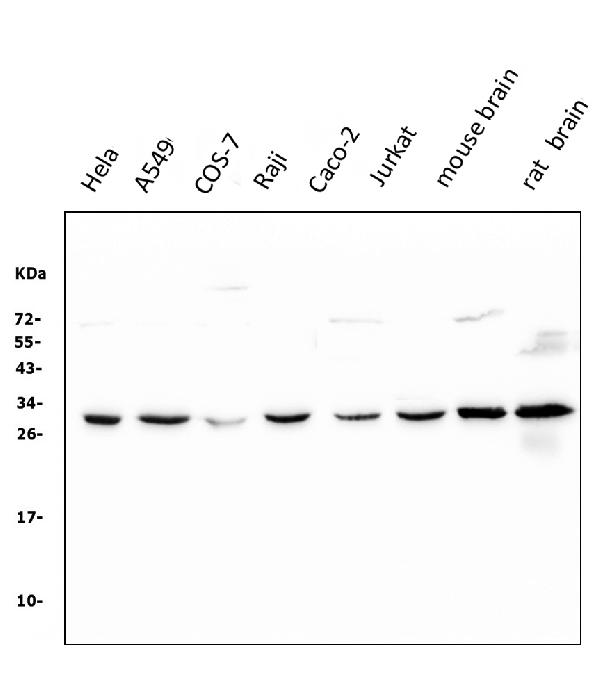Anti-14-3-3 zeta/delta/YWHAZ Antibody Picoband™ (monoclonal, 6H7)
- SPECIFICATION
- CITATIONS
- PROTOCOLS
- BACKGROUND

Application
| WB |
|---|---|
| Primary Accession | P63104 |
| Host | Mouse |
| Isotype | Mouse IgG1 |
| Reactivity | Rat, Human, Mouse, Monkey |
| Clonality | Monoclonal |
| Format | Lyophilized |
| Description | Anti-14-3-3 zeta/delta/YWHAZ Antibody Picoband™ (monoclonal, 6H7) . Tested in WB applications. This antibody reacts with Human, Monkey, Mouse, Rat. |
| Reconstitution | Add 0.2ml of distilled water will yield a concentration of 500ug/ml. |
| Gene ID | 7534 |
|---|---|
| Other Names | 14-3-3 protein zeta/delta, Protein kinase C inhibitor protein 1, KCIP-1, YWHAZ |
| Calculated MW | 28 kDa |
| Application Details | Western blot, 0.1-0.5 µg/ml, Human, Mouse, Monkey, Rat |
| Subcellular Localization | Cytoplasm. Melanosome. |
| Contents | Each vial contains 4mg Trehalose, 0.9mg NaCl, 0.2mg Na2HPO4, 0.05mg NaN3. |
| Clone Names | Clone: 6H7 |
| Immunogen | A synthetic peptide corresponding to a sequence in the middle region of human 14-3-3 zeta/delta, which shares 97.8% amino acid (aa) sequence identity with both mouse and rat 14-3-3 zeta/delta. |
| Purification | Immunogen affinity purified. |
| Cross Reactivity | No cross-reactivity with other proteins. |
| Storage | Store at -20˚C for one year from date of receipt. After reconstitution, at 4˚C for one month. It can also be aliquotted and stored frozen at -20˚C for six months. Avoid repeated freeze-thaw cycles. |
| Name | YWHAZ |
|---|---|
| Function | Adapter protein implicated in the regulation of a large spectrum of both general and specialized signaling pathways (PubMed:14578935, PubMed:15071501, PubMed:15644438, PubMed:16376338, PubMed:16959763, PubMed:31024343, PubMed:9360956). Binds to a large number of partners, usually by recognition of a phosphoserine or phosphothreonine motif (PubMed:35662396). Binding generally results in the modulation of the activity of the binding partner (PubMed:35662396). Promotes cytosolic retention and inactivation of TFEB transcription factor by binding to phosphorylated TFEB (PubMed:35662396). Induces ARHGEF7 activity on RAC1 as well as lamellipodia and membrane ruffle formation (PubMed:16959763). In neurons, regulates spine maturation through the modulation of ARHGEF7 activity (By similarity). |
| Cellular Location | Cytoplasm. Melanosome. Note=Located to stage I to stage IV melanosomes. |

Thousands of laboratories across the world have published research that depended on the performance of antibodies from Abcepta to advance their research. Check out links to articles that cite our products in major peer-reviewed journals, organized by research category.
info@abcepta.com, and receive a free "I Love Antibodies" mug.
Provided below are standard protocols that you may find useful for product applications.
Background
14-3-3 protein zeta/delta (14-3-3ζ) is a protein that in humans is encoded by the YWHAZ gene on chromosome 8. This gene product belongs to the 14-3-3 family of proteins which mediate signal transduction by binding to phosphoserine-containing proteins. This highly conserved protein family is found in both plants and mammals, and this protein is 99% identical to the mouse, rat and sheep orthologs. The encoded protein interacts with IRS1 protein, suggesting a role in regulating insulin sensitivity. Several transcript variants that differ in the 5' UTR but that encode the same protein have been identified for this gene.
If you have used an Abcepta product and would like to share how it has performed, please click on the "Submit Review" button and provide the requested information. Our staff will examine and post your review and contact you if needed.
If you have any additional inquiries please email technical services at tech@abcepta.com.













 Foundational characteristics of cancer include proliferation, angiogenesis, migration, evasion of apoptosis, and cellular immortality. Find key markers for these cellular processes and antibodies to detect them.
Foundational characteristics of cancer include proliferation, angiogenesis, migration, evasion of apoptosis, and cellular immortality. Find key markers for these cellular processes and antibodies to detect them. The SUMOplot™ Analysis Program predicts and scores sumoylation sites in your protein. SUMOylation is a post-translational modification involved in various cellular processes, such as nuclear-cytosolic transport, transcriptional regulation, apoptosis, protein stability, response to stress, and progression through the cell cycle.
The SUMOplot™ Analysis Program predicts and scores sumoylation sites in your protein. SUMOylation is a post-translational modification involved in various cellular processes, such as nuclear-cytosolic transport, transcriptional regulation, apoptosis, protein stability, response to stress, and progression through the cell cycle. The Autophagy Receptor Motif Plotter predicts and scores autophagy receptor binding sites in your protein. Identifying proteins connected to this pathway is critical to understanding the role of autophagy in physiological as well as pathological processes such as development, differentiation, neurodegenerative diseases, stress, infection, and cancer.
The Autophagy Receptor Motif Plotter predicts and scores autophagy receptor binding sites in your protein. Identifying proteins connected to this pathway is critical to understanding the role of autophagy in physiological as well as pathological processes such as development, differentiation, neurodegenerative diseases, stress, infection, and cancer.


